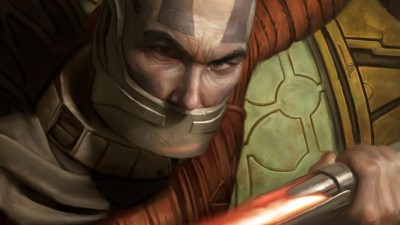Every game has a defining moment, a point that encapsulates everything brilliant about it in a snapshot window. It might be an unexpected boss encounter or a twist that turns everything you knew about a game upside-down. But what makes those moments definitive is the very same thing that makes them limited; they’re only the defining moment of one game.
This time around, we have a defining gaming moment in mind that is so definitive it went on to become the defining moment of not only one, but three games. It’s a moment that, for those that played the game in its prime, set the standard for obstinate bosses that refuse to die.
In 1993 Treasure, a newly-formed studio made up of ex-Konami developers, put out their first game: a Sega Genesis run-and-gun shooter entitled Gunstar Heroes.
The player guides the unimaginatively named “Red” (or “Blue” if you were player 2), members of a resistance group who are taking the fight to an evil empire. But this evil empire has an ace up its sleeve; they’ve brainwashed former resistance member “Green” and added him to their ranks. Sure, it’s all a bit basic and more than slightly ridiculous - but hey, this was the 90s. It was an interesting story premise for the time.
 In one level, the action takes place in a railway mine. But in a twist, the player can jump between riding the rails on the floor and the rails on the ceiling. In an added spin to that twist, the mineshaft alternates between running across the screen horizontally and down the screen vertically… wait, what?
In one level, the action takes place in a railway mine. But in a twist, the player can jump between riding the rails on the floor and the rails on the ceiling. In an added spin to that twist, the mineshaft alternates between running across the screen horizontally and down the screen vertically… wait, what?
Oh, right. It was the 90s.
Anyway, this stage gives the player the perfect chance to get used to the quirks of fighting on rails before they were put face-to-face against the end-level boss.
But the player is keenly aware that something isn’t right about this levels’ boss fight from the get go. Most boss fights in Gunstar Heroes are preceded by three lines of text, noting the boss’s name and two primary skills. This time though, the player is confronted with 21 lines of text, detailing the names and skills of seven different bosses.
The player braces, not entirely sure of what just happened. They don’t even remember what the first few lines of text said, and they aren’t given the time to remember either; as the text scroll ends, a hoverpad comes into view and riding atop it, menacingly aloof, is Green. The prospect of fighting Green was exciting in-and-of itself; he had all the skills, training and know-how that the heroes had, but he represented evil. and this was the 90s. The parallels that can be drawn with the Green Ranger from Mighty Morphin Power Rangers fame are coincidental, but that they can be drawn shows that the idea was exciting for children at the time.
Green glides over towards the left of the screen. In most run-and-gun games the player battles rightwards through the level until they reach the end-of-the-line-boss. The left of the screen is reserved as the de facto starting position for the player. By placing the boss on the left and players on the right the players’ expectations are subverted. The hunter becomes the hunted.
As Green moves towards the left of the screen platelets of armor materialize and lock into place around him. The first part of Seven Force, Soldier Force, takes shape; a humanoid mech that barrels down the mineshaft after the player at full pelt.
Players know Seven Force isn’t messing around because it throws its first punch, a trio of sickle like protrusions, before it’s even finished taking shape. Initially, you’ll think that avoiding those high-flying projectiles must be a simple case of sticking to the bottom of the screen. But this ill-gotten sense of confidence is promptly dashed when Soldier Force starts throwing homing punches around. Wherever the player goes, Soldier Force’s extending limbs can get to them.
Smarter players might realize that the top of the screen is a danger zone that leaves them open to both punches and projectile attacks, whereas being on the bottom of the screen halves risk. Even if they can’t be on the bottom of the screen all the time it appears to make sense to stay there for as long as possible.
Just one thing, Soldier Force knows that as well; stay on the bottom of the screen for too long and it will run in with a fluid slide attack that belies its size.
After keeping the heat on Soldier Force for long enough he shatters apart, exposing Green for a second. But this isn’t the end of the fight. Green summons another set of armor platelets around himself, this time taking the shell form of Urchin Force. The mineshaft shifts from horizontal to vertical. The landscape changes but the rules remain the same: keep moving.
Urchin Force pendulums into the sides of the stage several times before finally settling on one side of the screen, revving up and then grinding its way along the walls after the player. The distinct attack pattern makes this fight easy enough, but Urchin Force’s huge well of HP stretches this portion out. It’s one of the few times in the game where a boss attempts to wear a player out through attrition, and it helps drive home that Seven Force is one tough customer.
After a few minutes numb-fingered players emerge victorious over Urchin Force but they’re given no time to rest as the mineshaft reverts back to a horizontal orientation. And Green? He’s already phasing into the screen spanning Crab Force form.
Crab Force establishes itself on the left-side of the screen, from which it sends out waves of almost screen high walls towards the player. The only way to dodge them is to slide by in the one man high gap above or below each wall. The player alternates between the top and bottom of the screen as Crab Force dictates. It’s Seven Forces’ way of getting the player to play to the beat of its drum, making it not only the hunter, but the master as well.
Just as the player starts to feel comfortable with the rhythm, Crab Force crumples, the mineshaft switches orientation again and Green shifts into the next form of Seven Force, Tails Force. It’s not entirely clear which animal Tails Force is modeled on, but its stocky body and springy barbed tail are give it a distinctly aquatic look.
Tails Force is the only form of Seven Force that’s able to move freely (and unpredictably) through the air, as opposed to simply passing through it on a fixed attack path - a quirk that makes staying away from it (and its tail) a renewed challenge each time it’s fought. In comparison to the other forms of Seven Force which attempt to box the player in from a relatively fixed on screen location, Tails Force pursues the player omni-directionally.
Particularly stressful as it also happens to be the only form of Seven Force that pins the player to one surface. Moving between the ground and ceiling during horizontal sequences and between walls during vertical sequences allowed the player to get out of a pinch up until this point – this isn’t a viable strategy against Tails Force. Attempting to move behind Tails Force simply places the player closer to its barbed tail.
These minor shake-ups in the balance of power and fight tempo between each form keep the player from feeling fatigued to boredom, whilst the length of the fight impresses just how persistent Seven Force is. It’s at around this point mild irritation creeps in. Players begin to begrudge Seven Force: “Just die already!”.
But Seven Force isn’t ready to die yet. After Tails Force is dispatched Green transforms into the only form of Seven Force that isn’t modeled after some kind of living creature: Blaster Force. Gunstar Heroes is full of whacky, imaginative scenarios, but few are quite as insane or surreal as fighting Blaster Force, a giant spinning gold pistol (yes, really).
In yet another shift of pace, Blaster Force fires haphazardly in the players’ direction; at first it fires fast, then faster. Players are required to dance around the stage to stay clear of all the projectiles, but Blaster Force’s attacks keep picking up speed. Eventually the gap between shots closes so much that the player has no time to dodge. And where Blaster Force would normally fire on the player it just floats motionlessly. Confused, at first you might consider the possibility that the enemy’s AI scripting has failed and you’re encountering a bug.
But this is Treasure we’re talking about, and at this stage in the fight you’ve come to expect the unexpected.
Sure enough, Treasure has one more ace up its imaginative sleeve. Suddenly, part of Blaster Force drops off – the pistol grip. Wait, no, the ammo clip. In a moment of comic genius, you’ll realize why Blaster Forced stopped firing - it was
reloading. The mundanity of it all contrasts with the ludicrous concept of fighting a giant, levitating autonomously-firing pistol. Few games of this era had frames animated purely to convey character quirks, and the few that did (such as Sonic the Hedgehog’s impatient foot tapping animation) were reserved for fleshing out their protagonists. When people think of Seven Force, Blaster Force is likely the first thing that comes to mind, all because of this small dash of character.
With five forms down, the player wonders what could possibly be waiting for them next. They probably weren’t expecting Eagle Force; a bird shaped form which, rather than flying through the stage, climbs up it in sharp, erratic movements, its wings intermittently blocking the path behind it. Observant players realize that getting past Eagle Force requires they pass under its wings in the moment they fold.
Having carefully watched its movements players wait for the opportune moment to pass under Eagle Force. They smirk to themselves as it continues stupidly clawing its way upwards and off the top of the screen… the smirk disappears when, in defiance of both common sense and physics, Eagle Force drops off the top of the screen and proceeds to claw way back up the screen… whilst upside down. Seven Force is filled with stupefying defining moments of its own.
And it’s not the last example of the goofy tricks Seven Force has up its sleeve. During its last form, the aptly named, feline formed Tiger Force, it attacks players with a tail mounted laser canon… as if it were the most natural, obvious way for a tiger to attack.
After finally wearing down the last sliver of Tiger Force’s health, Seven Force blows up in a screen encompassing cloud of flame. You’ll breathe s sigh of relief now that the harrowing fight has reached its conclusion and Seven Force has been defeated. Little do you know, however, that Seven Force’s death defying… err… death defiance… isn’t over.
Seven Force would go on to stubbornly attack players again not only later into Gunstar Heroes, but once again in the 1995 release of Alien Soldier, and once more after that in the 2005 pseudo-remake of Gunstar Heroes, Gunstar Super Heroes for the Gameboy Advance. Treasure is well-known for packing its games with excellent boss designs, but Seven Force stands out as their most accomplished. That it came so early in the developer’s long career is all the more impressive, and in many ways Treasure has yet to top it.
These days it can be difficult to acquire the Sega Genesis version of Gunstar Heroes, making the digital re-releases on the PlayStation 3, Xbox 360 and Wii Virtual Console the most likely way players will get to experience Seven Force. However and whenever they do though, they’ll all reach that one point where they exclaim “Just die already!”






